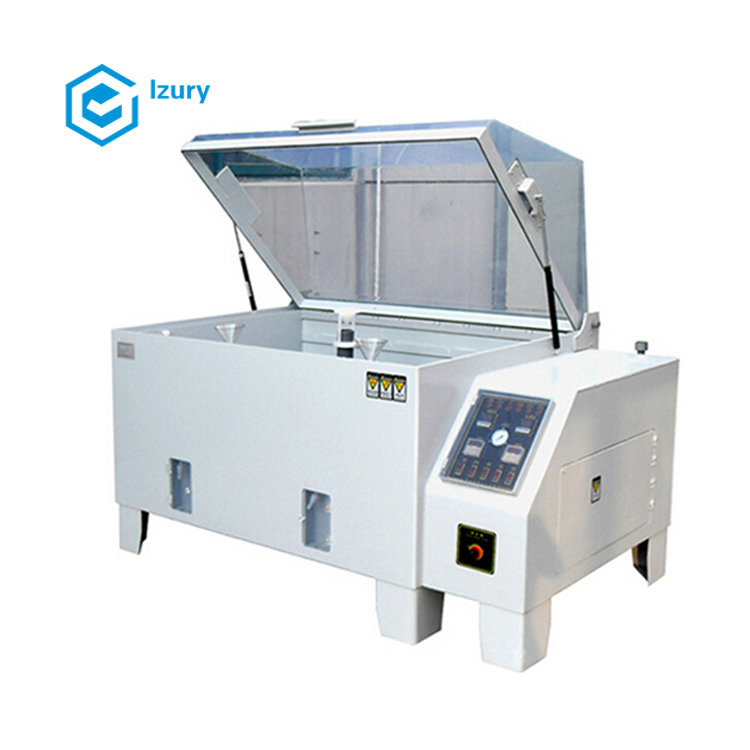
Salt Spray Test Chamber
Application:
Salt Spray Test Chambers are used to test a product or material in a highly corrosive environment for the purposes of evaluating the long-term effects of salt on an object and its ability to withstand the effects of corrosion. Environmental test chambers evaluate product quality and reliability, and identify manufacturing flaws and weaknesses in those products before they are released to the general market.

Testing:
The test results recorded through the process of salt spray testing can show the process of product decay and degradation and help predict the potential lifespan of a product or coating. Within the sealed test chamber, a salt-laden spray or a salt-fog (mainly sodium-chloride) is produced by a high-pressure nozzle to check the corrosion resistance of product coatings or coverings for products usually made from steel, brass and other metals.
Technical specification
Size | 60 | 90 | 120 | 160 | |
Test room inner size (LXWXHcm) | 60x45x40 | 90x60x50 | 120x100x50 | 160x100x50 | |
Test room out size (LXWXHcm) | 107x60x118 | 141x88x128 | 190x130x140 | 230x130x140 | |
Test room tem | NSS ACSS 35℃±1℃/CASS50℃±1℃ | ||||
Pressure barrel temperature | NSS ACSS 47℃±1℃/CASS63℃±1℃ | ||||
Salt water temperature | 35℃±1℃ | ||||
Test room capacity | 108L | 270L | 600L | 800L | |
Salt water capacity | 15L | 25L | 40L | 40L | |
Sodium chloride solution concentration 5% or Add sodium chloride solution at 5% concentration per liter CuCL2 | |||||
Compressed air pressure 1.00±0.01kgf/cm2 | |||||
Spray amount 1.0~2.0ml/80cm2/h | |||||
The relative temperature of the laboratory is over 85% | |||||
Spray mode continuous spray programmable spray (including continuous spray and intermittent spray) | |||||
Power | AC220V1φ10A | AC220V1φ15A | AC220V1φ30A | AC220V1φ30A | |
Salt Spray Test Chamber
Application:
Salt Spray Test Chambers are used to test a product or material in a highly corrosive environment for the purposes of evaluating the long-term effects of salt on an object and its ability to withstand the effects of corrosion. Environmental test chambers evaluate product quality and reliability, and identify manufacturing flaws and weaknesses in those products before they are released to the general market.

Testing:
The test results recorded through the process of salt spray testing can show the process of product decay and degradation and help predict the potential lifespan of a product or coating. Within the sealed test chamber, a salt-laden spray or a salt-fog (mainly sodium-chloride) is produced by a high-pressure nozzle to check the corrosion resistance of product coatings or coverings for products usually made from steel, brass and other metals.
Technical specification
Size | 60 | 90 | 120 | 160 | |
Test room inner size (LXWXHcm) | 60x45x40 | 90x60x50 | 120x100x50 | 160x100x50 | |
Test room out size (LXWXHcm) | 107x60x118 | 141x88x128 | 190x130x140 | 230x130x140 | |
Test room tem | NSS ACSS 35℃±1℃/CASS50℃±1℃ | ||||
Pressure barrel temperature | NSS ACSS 47℃±1℃/CASS63℃±1℃ | ||||
Salt water temperature | 35℃±1℃ | ||||
Test room capacity | 108L | 270L | 600L | 800L | |
Salt water capacity | 15L | 25L | 40L | 40L | |
Sodium chloride solution concentration 5% or Add sodium chloride solution at 5% concentration per liter CuCL2 | |||||
Compressed air pressure 1.00±0.01kgf/cm2 | |||||
Spray amount 1.0~2.0ml/80cm2/h | |||||
The relative temperature of the laboratory is over 85% | |||||
Spray mode continuous spray programmable spray (including continuous spray and intermittent spray) | |||||
Power | AC220V1φ10A | AC220V1φ15A | AC220V1φ30A | AC220V1φ30A | |